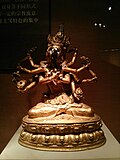Guhyasamaja Tantra
| Tibetan canon |
|---|
| Mainstream texts |
| Mahayana sutras |
| Tantras |
| Chinese canon |
|---|
| Mainstream texts |
| Mahayana sutras |
|
| Tantras |
|
The Guhyasamaja Tantra (Skt. Guhyasamāja-tantra; Tib. གསང་བ་འདུས་པ་, sangwa düpa, Wyl. gsang ba 'dus pa) is one of the most important tantras within Tibetan Buddhism.
The Princeton Dictionary states: "In Tibet, the tantra was highly influential, ranking in importance with the Hevajra Tantra, Chakrasamvara Tantra, and Kalachakra Tantra."[1]
Alexander Berzin writes:
- Guhyasamaja is considered one of the oldest, if not the oldest, tantra systems to surface in written form in India. And within the classification of tantra, the way that it’s classified in the so-called New Translation period (gSar-ma) is anuttarayoga tantra, which means that it’s dealing with the systems of the subtle body – chakras, channels, winds, these sorts of things – in order to gain access to the subtlest level of mental activity, so-called clear-light mind, and using that level of mental activity as the immediate cause for the Four Bodies of a Buddha.[2]
The Guhyasamaja Tantra survives in Sanskrit manuscripts and in Tibetan and Chinese translation.
With the Sarma tradition of Tibet, this text belongs to the Father tantra class of Highest Yoga Tantras.
History
According to the Tibetan tradition, this text was first taught by the Buddha, who manifested in the form of Vajradhara and taught the text to King Indrabhuti of Oddiyana.[2]
The first historical record of the text is from a Sogdian monk Amoghavajra in the mid-8th century, who included this text in a list of eighteen texts.[2]
Chinese translation
Seven chapters of the text were translated into Chinese by Danapala in 1002.[2][1]
According to Berzin, "the practice never really took off in China, so you don't have a tradition there..."[2] Buswell also states that the text was "not particularly influential in East Asian Buddhism".[1]
Tibetan translation
The present Kangyur includes a translation from the 11th century (during "new translation period") by Sraddhakaravarman and Rinchen Zangpo.[2][1]
The text was also translated in the "early translation period" by Vimalamitra and Kawa Paltsek (the first 17 chapters), by Buddhaguhya and Drogmi Palgyi Yeshé (chapter 18).[3]
Enlgish translation
The following English translation is available:
- Fremantle, Francesca (1971), A Critical Study of the Guhyasamāja tantra
Gallery
Thangka of Guhyasamaja in union with his consort Sparshavajrā, 17th century, Rubin Museum of Art
Statue of Guhyasamaja in union with consort, Capital Museum
References
- ↑ 1.0 1.1 1.2 1.3 Robert E. Buswell Jr., Donald S. Lopez Jr., The Princeton Dictionary of Buddhism (Princeton: 2014), s.v. Guhyasamājatantra
- ↑ 2.0 2.1 2.2 2.3 2.4 2.5
 What Is Guhyasamaja Practice?, StudyBuddhism
What Is Guhyasamaja Practice?, StudyBuddhism
- ↑ See Herrmann-Pfandt, Adelheid. “The Lhan kar ma as a Source for the History of Tantric Buddhism.” In Eimer Helmut, Germano David (eds.). The Many Canons of Tibetan Buddhism. PIATS 2000: Tibetan Studies: Proceedings of the Ninth Seminar of the International Association for Tibetan Studies, Leiden: Brill 2000: 141.
Further reading
- Āryadeva's Lamp that Integrates the Practices (Caryāmelāpakapradīpa): The Gradual Path of Vajrayāna Buddhism according to the Esoteric Community Noble Tradition, edited and translated by Christian K. Wedemeyer (New York: American Institute of Buddhist Studies/Columbia University Press, 2007), ISBN 978-0975373453
- Fremantle, Francesca (1971), A Critical Study of the Guhyasamāja tantra
- Wedemeyer, Christian K. 2007. Āryadeva's Lamp that Integrates the Practices: The Gradual Path of Vajrayāna Buddhism according to the Esoteric Community Noble Tradition. New York: AIBS/Columbia University Press. ISBN 9780975373453
- Geshe Tashi Tsering p. 78 of 240 July 3, 2012. Tantra: The Foundation of Buddhist Thought Volume 6. London: Wisdom Publications. ISBN 1614290113 ISBN 9781614290117
- Brilliant Illumination of the Lamp of the Five Stages, Columbia University Press, 2011, ISBN 978-1-93-501100-2
- A Lamp to Illuminate the Five Stages, Library of Tibetan Classics, 2013, ISBN 0-86171-454-7
External links
 What Is Guhyasamaja Practice?, StudyBuddhism
What Is Guhyasamaja Practice?, StudyBuddhism- Encyclopædia Britannica, Guhyasamāja-tantra
- Tsongkhapa, A Lamp to Illuminate the Five Stages, Wisdom Publications
 Guhyasamāja Tantra, Wikipedia
Guhyasamāja Tantra, Wikipedia Guhyasamaja Tantra, Rigpa Shedra Wiki
Guhyasamaja Tantra, Rigpa Shedra Wiki

